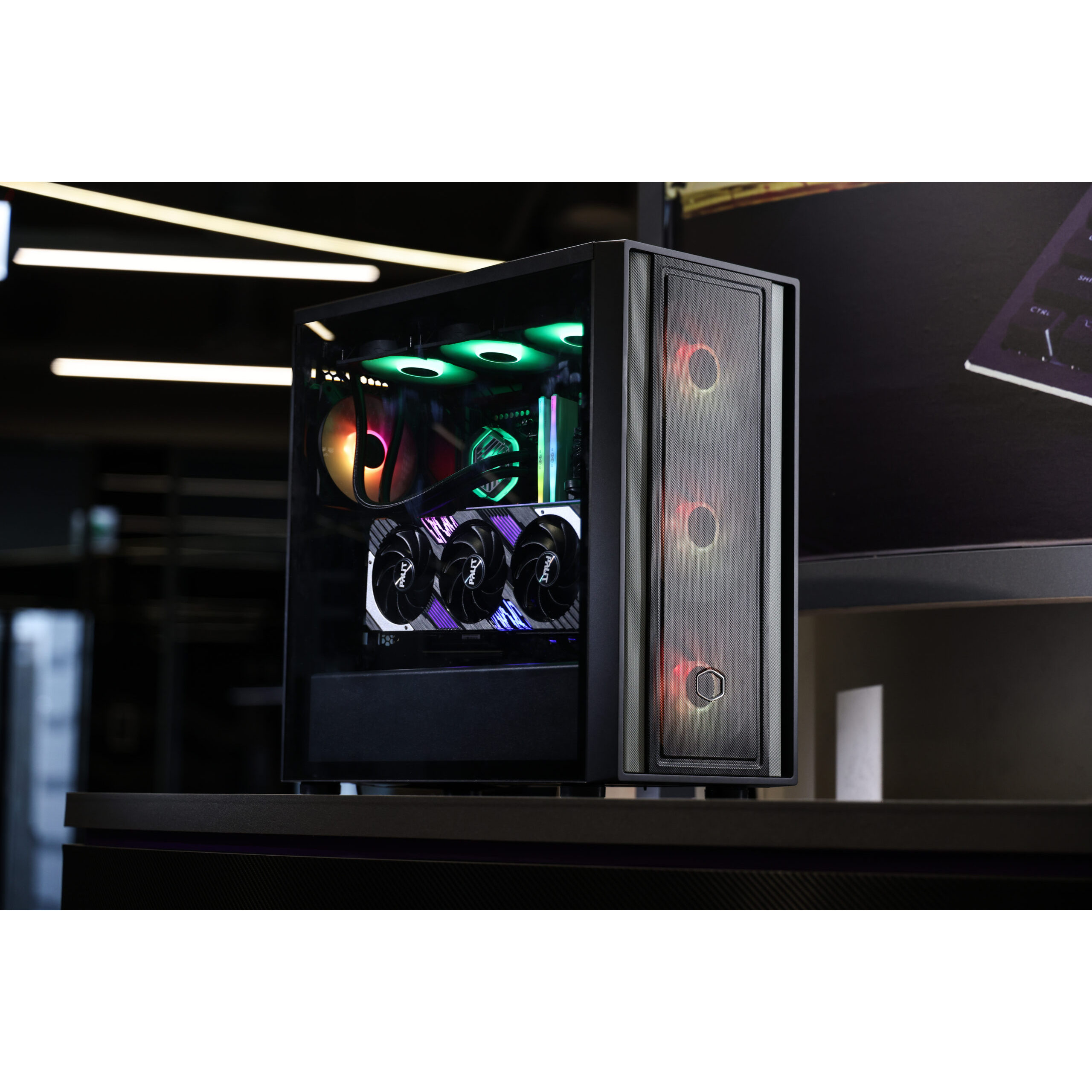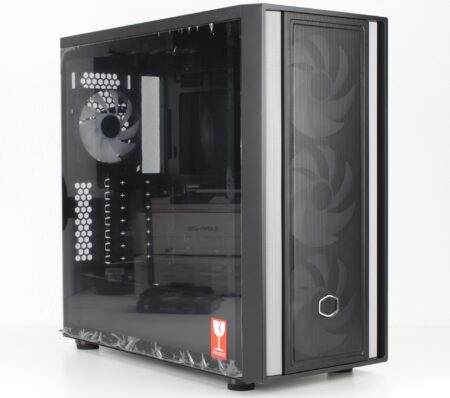CONS
- Breakaway PCIe slot covers, with no replacements included
- Poor dust control
- Noisy with stock fans
COOLER MASTER MASTERBOX 600 SPECS
| Motherboard Form Factors Supported |
ATX, MicroATX, Mini-ITX |
| Internal 3.5-Inch Bays |
2 |
| Internal 2.5-Inch Bays |
6 |
| Front Panel Ports |
USB 3.2 Gen 2 Type-C, USB 3.2 Gen 1 Type-A (2), HD Audio |
| Side Window(s)? |
Yes (Tempered Glass) |
| PCI Expansion Slot Positions |
7 |
| 120mm or 140mm Fan Positions |
7 |
| 120mm to 200mm Fans Included |
4 |
| Fan Controller Included? |
|
| Maximum GPU Length |
410 mm |
| Maximum CPU Cooler Height |
170 mm |
| Power Supply Maximum Length |
220 mm |
| Power Supply Form Factor Supported |
ATX |
| Power Supply Mounting Location |
Bottom |
| Internal Chassis Lighting Color |
None |
| Included Fan Lighting Color |
Addressable RGB |
| Dimensions (HWD) |
19.0 by 9.1 by 18.6 inches |
| Weight |
17.3 lbs |
Value-conscious PC builders who prioritize investing in internal components should take note: The MasterBox 600 is constructed with a mere 13 pounds of steel and plastic, featuring a tempered-glass side panel. Despite offering little beyond a collection of fans and radiator mounts, our main focus is on ensuring optimal airflow and minimal noise levels. While the MasterBox is a visually appealing ATX chassis suitable for air-cooling, those seeking better value may want to consider alternatives such as the Montech Air 903 Max or Enermax StarryKnight SK30 v2, unless the design of the MasterBox specifically appeals to you.
Design: Maximizing the Potential of a Hundred Dollars.
Cooler Master has implemented some impressive design elements using minimal materials to enhance the stability of its case. This is evident in the intricate pressed pattern on its steel mesh face. The case also features three 140mm ARGB fans, and it can accommodate a 420mm-format radiator up to 457mm in length.
The front-panel ports can be found in close proximity to the front of the right edge of the top panel. These ports consist of two USB Type-A ports and one Type-C port, all connected with cables that are compatible with their respective generations. In front of these ports, there is a four-pole headset jack that allows for both stereo headphone and monaural microphone connections. Additionally, there is a small plastic window that reveals an LED indicating hard drive activity. The reset button has been repurposed to switch modes for an included ARGB controller, while the power button emits a glowing light through its power LED backlight.
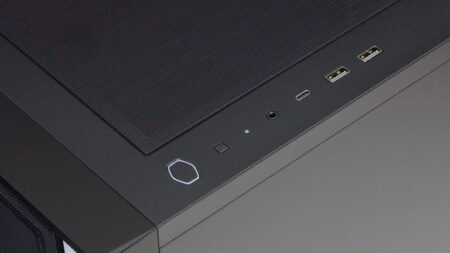
Located at the rear is a 120mm ARGB fan provided by the factory (installed on adjustable slots that offer approximately one inch of height adjustment), along with seven expansion slots and a dual-pattern mount that enables power supplies to be installed with the lid facing upwards or downwards.
The presence of a dark spot in the lower rear corner of the right side panel (as seen in the left side of the photo) can be attributed to a protrusion on the inner mounting bracket. This occurrence took place when the reviewer unintentionally created a thumb-shaped dent on the nearby metal while attempting to push in the aforementioned protrusion using their thumb. It is worth noting that the metal in question possesses a certain degree of flexibility.
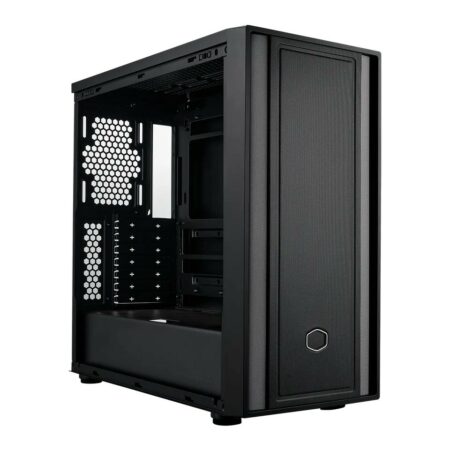
All seven slot covers are removable knock-outs that can be detached for use. Before installing the motherboard, it is important to remove the breakouts from any slots you plan to open up, as the back edge of the motherboard may obstruct them (and it is advisable to avoid damaging the motherboard while removing them). Only the slot covers that match the position of your graphics (or other expansion) card should be removed, as the case does not provide any replacement slot covers. Best of luck!
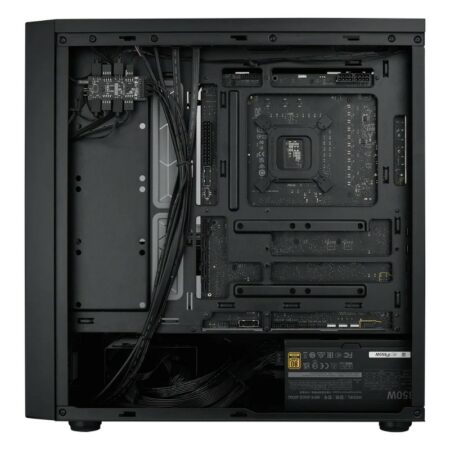
The MasterBox 600 lacks dust-filtering provisions at its front, making the face the primary dust catcher. The perforations on the silver panels seem to be slightly smaller compared to those on the black portion.
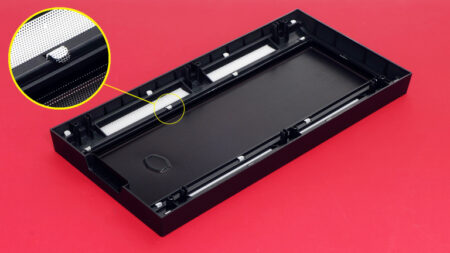
The motherboard tray of the MasterBox 600 is equipped with a comprehensive range of features. These include “back plug-in” cutouts, designed for reversed cable connectors, which are compatible with both ATX and MicroATX motherboards that have reverse connectors. Additionally, there are extra cable passages for boards that do not have this feature. Another notable feature on the tray is a large hole that facilitates the installation of socket support plates that come with specific CPU coolers. Furthermore, grommets are provided to conceal a portion of any cables inserted at the forward edge of ATX or MicroATX motherboards. Lastly, there are mounting holes that support 2.5-inch drives in five different locations.
Observant individuals may also spot various openings on the power-supply cover, such as three positioned at the rear for HD Audio, ARGB, USB, and front panel headers, one that lines up decently with the PCIe power headers found on the majority of graphics cards, and a large 3.5-inch space designed for accommodating a 420mm-format radiator.
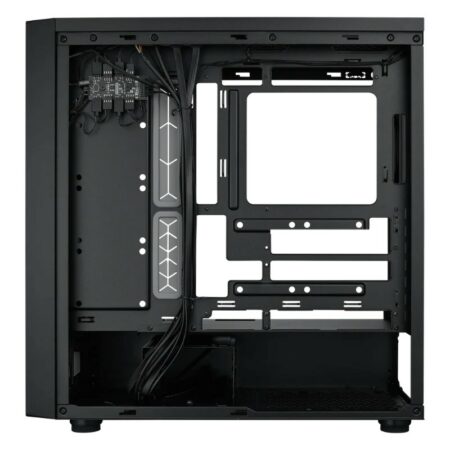
Builders utilizing the upper panel for exhaust will discover that the sole dust filter available is located at the power-supply inlet on the lower part of the MasterBox 600. This filter is fastened with tabs, making it challenging to remove and reinstall. The inner 3.5-inch drive cage is secured by inward-facing tabs and screw holes adjacent to it.
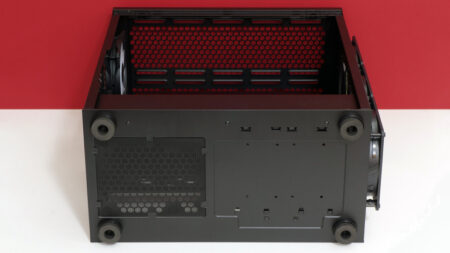
The inner mechanisms are exposed when viewed from a different perspective, showcasing the top panel with a triple-fan-mount, the three front-mounted 140mm ARGB intake fans, the ARGB/fan hub, and the 3.5-inch drive cage situated at the bottom.
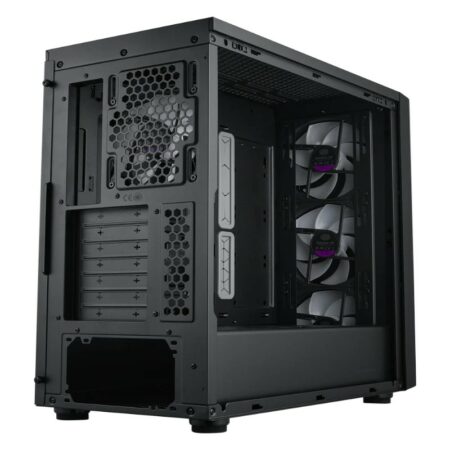
The upper panel is designed to accommodate three 120mm fans, but it cannot fit more than two 140mm fans due to space constraints. The mounting area can support radiators up to 360mm in length, with a maximum of 422mm, however, radiator and fan combinations thicker than 52mm will extend beyond the top edge of the motherboard. Luckily, the mount’s offset to the left allows for approximately 44mm of horizontal clearance for bulkier cooling setups.
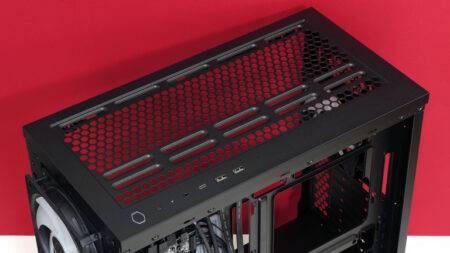
The MasterBox 600 comes with a hub that can accommodate up to four fans and five ARGB devices. This design choice by Cooler Master seems to indicate their intention to provide builders with the option to add one of their ARGB-equipped graphics-card braces. Interestingly, the case’s “reset” button serves a dual purpose as the hub’s ARGB controller. Builders can use this button to cycle through 14 different patterns or turn off the lighting effects by holding it for a few seconds. On the other hand, if the device’s external ARGB input is connected to another ARGB source, such as the motherboard, it will switch to passive hub mode and disable its control features completely. (More details on the graphics-card braces will be discussed shortly.)
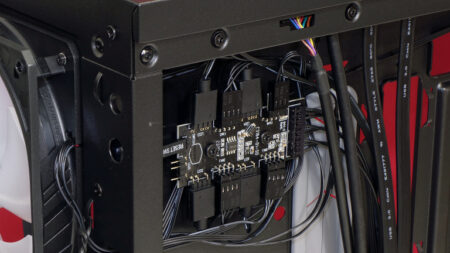
The included 3.5-inch clip-on drive rails are supported by the lower drive cage. Additionally, the cage features a set of holes in the same 2.5-inch pattern as the ones on the motherboard tray. Positioned 8.7 inches (221mm) away from the power supply mount and 89mm (3.5 inches) from the front panel, the cage can also be shifted forward by 44mm (1.75 inches) to create more space for the power supply, while reducing the area available for the radiator.
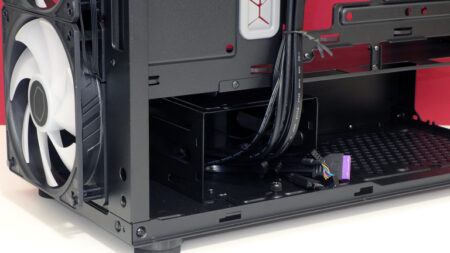
It is not our belief that anyone is not making an effort to provide accurate dimensions, but sometimes there are discrepancies that arise during the translation or rounding process. To illustrate this, the dimensions we previously provided suggest that one could remove the drive cage, install a radiator up to 44mm thick, reinsert the cage, and still have approximately 264mm of space behind the drive cage for the power supply. However, Cooler Master claims that a radiator cannot fit when the cage is in the forward position, and that only 210mm of space is available with the cage slid forward, contrary to our measurement of 220mm with the cage slid back. While it is possible that the 10mm difference between Cooler Master’s statement and our measurement accounts for the lip that protrudes inward from the outer edge of the case, the company’s assessment of the cage position seems slightly inaccurate.\
We conducted three measurements, and on all three occasions, we determined that the buyer is receiving slightly more space for this particular component than what Cooler Master has stated they are paying for.
Building With the MasterBox 600.
Cooler Master included the Atlas ARGB GPU Support stand, which is sold separately for around, with our MasterBox 600 sample. Although we acknowledged that using it wouldn’t enhance performance (i.e., no unfair advantage), we still opted to incorporate it into our current build. However, it’s important to note that the stand is not included in the of the product.
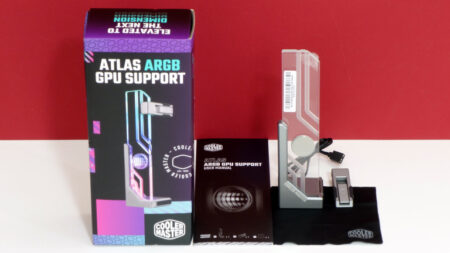
The package we provide contains the necessary hardware to successfully install a motherboard, seven cards, two 3.5-inch drives, and two 2.5-inch drives. Specifically, the bag includes 16 #6-32 screws that can be used to fill the nine holes of most ATX motherboards, with seven screws remaining to fill the card bracket holes of the slot panel. The 3.5-inch drive rails do not require screws for installation. Additionally, there are eight M3-threaded studs and matching grommets available to securely mount 2.5-inch drives onto two of the six mounts. However, it is possible for resourceful builders to distribute this hardware differently and still achieve successful installation.
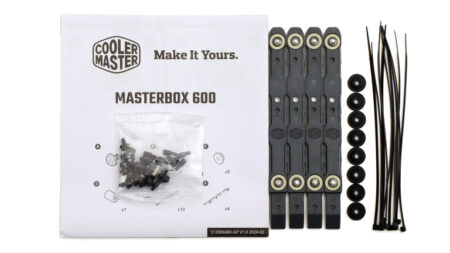
After the hardware has been installed, the next step is to establish connections using cables. The ARGB/fan hub comes with inputs for ARGB-signal, PWM-signal, and SATA-power. Additionally, the case includes a front-panel button/indicator LED plug, an HD Audio lead for the headset combo jack, a Type-E header for the Type-C front-panel port, and a 19-pin USB 3.2 connector for the two Type-A ports.
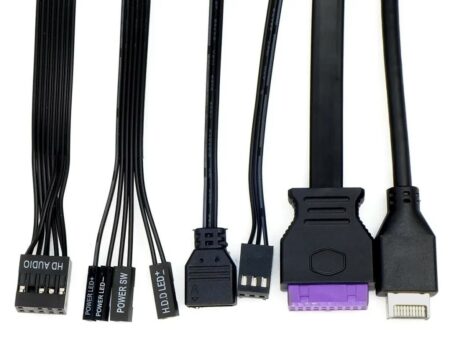
Were you aware that the MasterBox 600 provides ample space for mounting an Extended ATX motherboard, with the exception of three additional standoffs required to secure the front edge of the largest (13-inch-deep) variant? Our team noticed this, which implies that you can easily mount one of the commonly known EATX-labeled boards without any problems. These so-called EATX gaming and HEDT (high-end desktop) boards typically have a depth that is only one inch greater than the ATX model showcased.
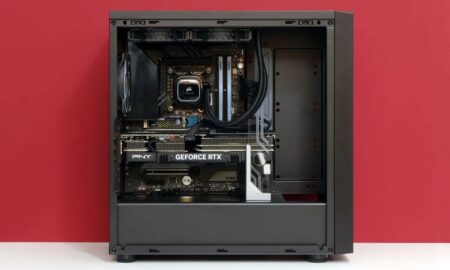
And this is our build featuring our test components. Indeed, the inclusion of the additional stand, which comes at an extra cost of enhances the system’s prominence beyond what it would have been otherwise.
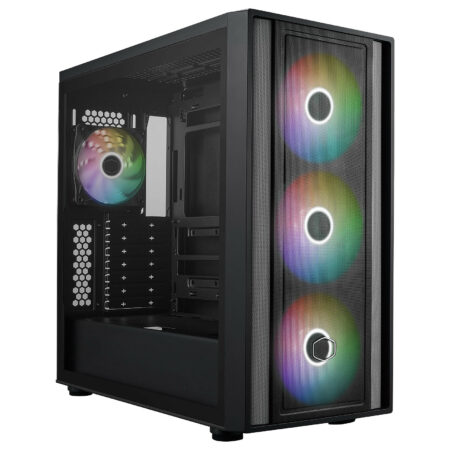
Regarding the card supported by the ARGB stand, it happens to be the well-known Verto Triple-Fan RTX 4070 Ti manufactured by PNY…
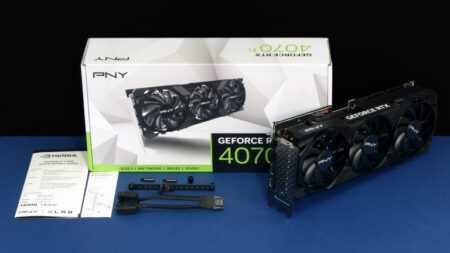
We have chosen the new card for our case-testing activities. By the way…
We have selected the new card to use for our case-testing efforts. On that note…
Regrettably, the two configurations of the same fanless case performed poorly. Despite ranking third in voltage-regulator temperature, it managed to secure second place in GPU cooling. However, it was disheartening to observe the MasterBox 600 tying for the last place in noise emissions.
Judgment: Sturdy ATX Case for Affordable Air Circulation.
The MasterBox 600 offers ample space for mounting large coolers and provides sufficient fans to maintain interior cooling. Similarly, the Enermax StarryKnight SK30 v2, offers the same features. The distinguishing factor between the two is the MasterBox 600’s ability to accommodate a 420mm-format radiator on the front panel, giving it an edge depending on your build requirements. However, for a standard build, the SK30 offers slightly better value.

